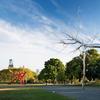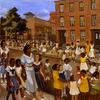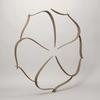'Sporting Fashion: Outdoor Girls 1800 to 1960' Exhibition Begins National Tour; Catalogue Foreword by Serena Williams
- NEW YORK, New York
- /
- June 24, 2021
The American Federation of Arts (AFA) has announced the opening of Sporting Fashion: Outdoor Girls 1800 to 1960, a traveling exhibition organized by the American Federation of Arts and the FIDM Museum at the Fashion Institute of Design & Merchandising, Los Angeles. Sporting Fashion is the first exhibition to explore the evolution of women’s sporting attire in Western fashion over this 160-year period. The exhibition includes sixty-five fully accessorized ensembles comprised of more than 480 historic objects selected from the exceptional collections of the FIDM Museum.
Opening July 3, 2021, the exhibition debuts at The Frick Pittsburgh, PA (July 3–September 26, 2021) and subsequently will travel to seven institutions across the United States through 2024, including presentations at the Dixon Gallery and Gardens, Memphis, TN (July 24–October 16, 2022); the Figge Art Museum, Davenport, IA (February 11–May 7, 2023); the Munson-Williams-Proctor Arts Institute, Utica, NY (June 17–September 17, 2023); the Taft Museum of Art, Cincinnati, OH (October 14, 2023–January 14, 2024); and the Cummer Museum of Art & Gardens in Jacksonville, FL (February 24–May 19, 2024); with its final stop at the FIDM Museum in Los Angeles, CA. Visit https://www.amfedarts.org/sporting-fashion/ for details of the national tour.
The exhibition includes garments and accessories from long-established sportswear brands such as Champion, Pendleton, Spalding, and Stetson, in addition to garments and accessories from key fashion brands such as Abercrombie & Fitch, Balenciaga, Chanel, Patou and Pucci.
“It’s an absolute delight to share this fascinating presentation of women’s activewear with a range of museum audiences,” said Pauline Willis, Director and CEO of the American Federation of Arts. “Covering athletic pursuits from fencing to motorcycling, Sporting Fashion: Outdoor Girls 1800 to 1960 offers valuable insight into the cultural, economic, and technical motives behind women’s sporting attire. As dialogues regarding women’s parity in athletics continue, Sporting Fashion enriches the conversation, illustrating the dynamic ways that modern women engaged in sport during the nineteenth and twentieth centuries.”
“This fifteen-year project took us down many paths as we gathered together the very rare objects, many not found in other museum collections,” said Kevin L. Jones, Curator at the FIDM Museum. “Not only are we displaying more than sixty-five original ensembles, but we are excited to highlight sixteen sportswomen, and their varied accomplishments, whom most people will not have heard of before. Every single woman you see represented in these clothes was the modern woman, whether it was the 1820s or the 1920s.”
”Representing the modern athlete of today, we are honored that Serena Williams—international tennis champion and fashion icon—wrote the foreword to the exhibition catalogue,” said Barbara Bundy, Director of the FIDM Museum.
Sporting Fashion: Outdoor Girls 1800 to 1960 highlights the ensembles that defined women’s participation in the sporting world as athletes and spectators. The exhibition begins at the turn of the nineteenth century, outside the domestic sphere, and concludes with the mid-twentieth century when basic forms of women’s sportswear we know today were codified. Examining the competing priorities of fashion, function, and propriety, Sporting Fashion will feature sixty-five fully accessorized ensembles and a selection of sport-related accessories and ephemera, all drawn from the exceptional collections of the FIDM Museum.
The subtitle Outdoor Girls is inspired by the printed script on a circa 1946 wool scarf, which depicts women engaged in thirteen different sports, including golf, horseback riding, ice-skating, and tennis. The exhibition will include ensembles worn for over forty other outdoor activities over the course of the nineteenth and twentieth centuries, each carefully assembled based upon extensive primary-source research. The exhibition will include ensembles for activities ranging from traveling to calisthenics, and from motorcycling to promenading.
Organized into six themes, Sporting Fashion: Outdoor Girls 1800 to 1960 will explore how clothing met the needs of new pursuits for women, while at the same time preserving their socially approved, restricted mobility. Garments for swimming and tanning will illustrate how innovative designers and manufacturers responded to the increasing acceptance of exposed skin at beaches and pools; winter sports ensembles will show how apparel for pastimes such as skiing and ice-skating protected female participants from the elements; and ensembles for cycling, motoring, and flying—often adapted from men’s athletic gear—will reveal how women navigated open roads and skies. To complement the artifacts on view, a timeline of key events and biographies of sixteen important sportswomen will further situate sporting fashion in the broader context of women’s social history.















